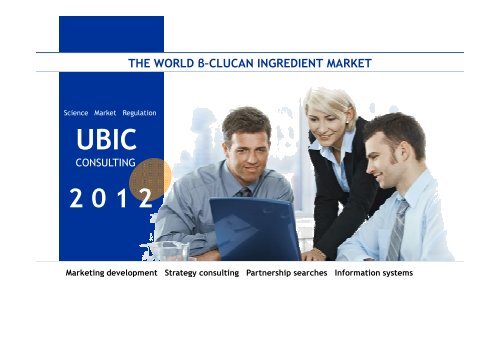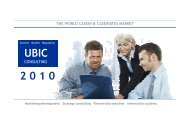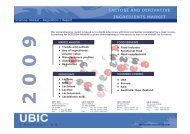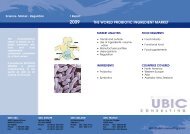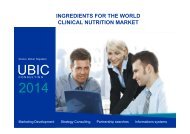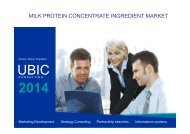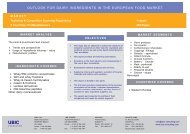The World Beta Glucan Ingredient Market - UBIC-Consulting
The World Beta Glucan Ingredient Market - UBIC-Consulting
The World Beta Glucan Ingredient Market - UBIC-Consulting
Create successful ePaper yourself
Turn your PDF publications into a flip-book with our unique Google optimized e-Paper software.
Science <strong>Market</strong> Regulation<br />
<strong>UBIC</strong><br />
CONSULTING<br />
2 0 1 2<br />
THE WORLD β–CLUCAN INGREDIENT MARKET<br />
<strong>Market</strong>ing development Strategy consulting Partnership searches Information systems
SCIENCE – MARKET – REGULATION - MANUFATURERS<br />
This comprehensive report is based on in-depth interviews with food companies completed by a desk review.<br />
It provides for DECISION MAKERS a global understanding of the sector as well as an outlook on its future.<br />
New trends and perspectives<br />
Use of ingredients: volumes-value<br />
Manufacturers profiles<br />
User’s opinion<br />
Regulation<br />
β-<strong>Glucan</strong><br />
<strong>Market</strong> Analysis Food Segements<br />
Food industry<br />
Cosmetics<br />
Pharmacy<br />
Industrial markets<br />
<strong>Ingredient</strong>s Covered Countries Covered<br />
North America<br />
Western Europe<br />
Asia<br />
Australia- New Zealand<br />
350 pages
O B J E C T I V E S<br />
M A R K E T<br />
Consumer trends<br />
Evaluate the world market<br />
Prospective<br />
M A N U F A T U R E R S<br />
Food industry orientations<br />
Applications in food<br />
segments<br />
Industrial users<br />
expectations<br />
R E S E A R C H<br />
Publications<br />
E N V I R O N M E N T<br />
Regulatory aspects<br />
Competitive environment<br />
THE WORLD β–GLUCAN INGREDIENT MARKET<br />
INTRODUCTION<br />
Origin and Characteristics<br />
<strong>Beta</strong>-glucans (BGs) occurs naturally in the bran of barley,<br />
oats, and wheat, and can also be extracted from the cell<br />
walls of bakers yeast (Saccharomyces cerevisiae).<br />
Chemically, BGs consist of linear unbranched<br />
polysaccharides of linked b-(1� 3)- and b-(1 � 4)- or b-<br />
(1 � 6) D-glucopyranose units.<br />
Research has shown that insoluble (1,3/1,6) beta glucan,<br />
has greater biological activity than that of its soluble<br />
(1,3/1,4) beta glucan counterparts. <strong>The</strong> differences<br />
between beta glucan linkages and chemical structure are<br />
significant in regards to solubility, mode of action, and<br />
overall biological activity.<br />
Viscosity-related properties<br />
Health Benefits<br />
ß-glucan is a natural soluble fibre, which forms viscous<br />
aqueous solutions and increases the viscosity of gut<br />
contents in the human alimentary tract. Soluble fibres are<br />
quite sought in human nutrition:<br />
• absorption of cholesterol; thus resulting in a lower<br />
blood cholesterol level, which stands for one of the<br />
risk factors of cardiovascular diseases.<br />
• their viscosity also makes the gastric content<br />
thicker, which slows down the absorption rate of<br />
glucose. ß-glucan thus spread glucose<br />
absorption over time (reduction of glycaemic<br />
index) and helps the body to fight against<br />
diabetes.<br />
• As dietary fibers assist the digestive process,<br />
BGs have a role in the prevention of certain large<br />
intestine diseases including cancer of the colon<br />
and diverticulitis.
INTRODUCTION<br />
Immunological properties<br />
As external immunomodulators, beta-1,3-d-glucans<br />
stimulates antitumour and antimicrobial activity, for<br />
example - by binding to receptors on macrophages<br />
and other white blood cells and activating them.<br />
Some health researchers indeed regard BG to be<br />
one of the most effective immune enhancing<br />
substances ever discovered.<br />
In the medical field, some Labs are doing research<br />
to develop 1,3- ß-glucan synthesis inhibitors to<br />
control P.carinii pneumonia which is a major cause of<br />
death in AIDS. For example, Merck in 2001 launched<br />
Caspofungin, an antifungal drug.<br />
In cosmetics, ß-glucan’s immune functions can help<br />
supporting the Langerhans cells immune system’s<br />
ability declining with age.<br />
Activated Langerhans cells synthesize a number of<br />
cytokines that have effects on the cells of the skin<br />
and the immune system. In particular, activated<br />
Langerhans cells synthesize factors that stimulate<br />
the proliferation of fibroblasts (skin cells), stimulate<br />
the synthesis of collagen, elastin, proteoglycan, and<br />
other components of skin, giving the skin new vigor,<br />
increased elasticity, and suppleness.<br />
THE WORLD β–GLUCAN INGREDIENT MARKET<br />
Main uses<br />
<strong>The</strong> main use of beta-glucans is<br />
• in texturizing as fat substitutes. Its use could<br />
include frozen desserts, breakfast foods,<br />
beverages, meats, non-dairy creamers, canned<br />
soups and bakery item.<br />
But beta-glucans are also recognized as having<br />
important positive health benefits :<br />
• As soluble dietary fibers, they bind with organic<br />
molecules, and are reported to reduce total<br />
plasma cholesterol and lower the glycemic index<br />
of food. <strong>The</strong>y thus have a protective effects<br />
against a range of diseases predominant in<br />
Western developed countries including coronary<br />
heart disease, diabetes, and obesity.<br />
• As external immunomodulators, beta-1,3-dglucans<br />
stimulates anti-tumour and antimicrobial<br />
activity, for example - by binding to receptors on<br />
macrophages and other white blood cells and<br />
activating them. Many health researchers indeed<br />
consider it to be one of the most effective immune<br />
enhancing substances ever discovered.<br />
• As an active ingredient in personal care products:<br />
β-<strong>Glucan</strong> can find its application in cosmetic<br />
production, in creams and lotions for sensitive<br />
and irritated skin . Preparations isolated from oat,<br />
containingβ-glucan, are used for skin irritated by<br />
different causes. <strong>The</strong>ir characteristics are fast<br />
skin hydration and soothing of redness and<br />
irritation.<br />
Viscosity properties of BG can be used in the bakery<br />
industry in products such as biscuits and pastas. Its<br />
use could also include frozen desserts, breakfast<br />
foods, beverages, meats, non-dairy creamers, and<br />
canned soups, especially as fat replacer.<br />
In particular:<br />
INDUSTRIAL BENEFITS<br />
• <strong>The</strong> cheese industry can benefit from betaglucans<br />
which optimize the process of raw<br />
material and improves the cheese structure.<br />
• <strong>The</strong> combination of inuline and beta-glucan also<br />
has very interesting properties that can be used<br />
as fat-replacers in products such as low-fat icecreams.<br />
This has been proved to be very<br />
successful.<br />
BG can also be used for a wide range of beauty- and<br />
health-oriented cosmetics:<br />
• Moisturizes the skin with a smooth and silky<br />
texture.<br />
• Ideal for the request from customers who wish to<br />
minimize damage to clear appearance, color, and<br />
scent stemming from the addition of β-glucan<br />
(Fermented <strong>Beta</strong>-<strong>Glucan</strong>).<br />
A number of skin care treatments are on the market:<br />
For instance; Penny Island’s exclusive Oat Amino<br />
Complex introduces new advanced oat delivery<br />
systems that are able to deliver more of the moisture<br />
retention, collagen and new cell production, anti<br />
irritant, anti oxidant and moisture barrier properties of<br />
oats.
POSSIBLE SOURCES<br />
Oat is the main source used, as it is also the only<br />
source eligible for a health claim. Moreover, oat is an<br />
interesting source compared to yeast as it contains a<br />
higher proportion of beta-glucan. However, other<br />
sources such as barley could also be very<br />
interesting. More barley is being grown in many<br />
countries, and it is also a product from the brewery<br />
industry. Some research is currently being done to<br />
improve barley value and use in beta-glucan food<br />
industry.<br />
In skin care products, beta glucan is derived from the<br />
cell walls of baker’s yeast (Saccharmoyces<br />
cerevisiae) by fermentation. Purified form of<br />
betaglucane from yeast cell walls is by far the most<br />
active in stimulating the body’s immune system<br />
TECHNOLOGICAL SOURCES<br />
<strong>The</strong> technological difficulties encountered are very<br />
much dependant on the result which is targeted in<br />
term of betaglucan content. <strong>The</strong>se difficulties mainly<br />
consist in viscosityrelated problems: viscosity results<br />
in a sticky pulp which is difficult to manipulate by<br />
food industry technology. Yet this can be bypassed<br />
by the addition of starch, and by carefully selecting<br />
the raw oat source according to their original<br />
betaglucan content. Indeed, different varieties of oat<br />
show different beta-glucan content and the choice of<br />
the primary source is essential to reach proper<br />
concentration in the final product. It is thus possible<br />
to reach a 20 percent content by using traditional<br />
milling technique that doesn’t involve any chemicals<br />
or solvent such as alcohol.<br />
THE WORLD β–GLUCAN INGREDIENT MARKET<br />
In order to reach higher levels, extraction<br />
techniques must be used. Extraction techniques are<br />
always a complex issue whatever the ingredient<br />
involved. As far as beta-glucans are concerned,<br />
difficult extraction processes are available, but<br />
much simpler ones have also been worked out.<br />
Peter Wood in Canada was able to perform simple<br />
ways of extraction, and studies on beta-glucan<br />
extraction are also conducted in Australia and New<br />
Zealand.<br />
REGULATION<br />
Regulation is a critical point as far as beta-glucan<br />
market is concerned. <strong>The</strong> legislation regarding<br />
health claim is different from one country to<br />
another, even within Europe.<br />
<strong>The</strong> effects on glucose levels can be claimed all<br />
over the word, but it is not true for other health<br />
claims such as those regarding cholesterol effects.<br />
Only Canada, Sweeden, Finland, UK and the US<br />
are now able to make health claim about<br />
cholesterol benefits.<br />
US<br />
<strong>The</strong> Quaker Oats Co. and Rhodia, Inc. have indeed<br />
issued a petition to the Food and Drug<br />
Administration (FDA) in april 2002. This petition has<br />
been approved: Summary of the 2002 health claim:<br />
<strong>The</strong> Food and Drug Administration (FDA) is<br />
amending the regulation authorizing a health claim<br />
on the relationship between beta-glucan soluble<br />
fiber from whole oat sources (rolled oats, oat bran,<br />
and whole oat flour ) and reduced risk of coronary<br />
heart disease (CHD).<br />
.<br />
<strong>The</strong> amendment adds as an additional eligible<br />
source of whole oat beta-glucan soluble fiber: the<br />
soluble fraction of alpha-amylase hydrolyzed oat<br />
bran or whole oat flour with a beta-glucan soluble<br />
fiber content of up to 10 percent on a dry weight<br />
basis (dwb) and not less than that of the starting<br />
material (dwb). Thus now, not only whole oat, but<br />
also manufactured concentrated sources of betaglucans<br />
(up to 10 percent) can also be claimed to<br />
benefit our health. However, the FDA limits the<br />
substance that is the subject of the health claim to<br />
the soluble fraction of alpha-amylase hydrolyzed oat<br />
bran or whole oat flour. It doesn’t include acid-base<br />
hydrolysis of whole oat flour or oat bran.<br />
<strong>The</strong> FDA reached this conclusion as they observed<br />
that the type of soluble fiber found in whole oats, i.e.,<br />
beta-glucan soluble fiber, is the component primarily<br />
responsible for the hypocholesterolemic effects<br />
associated with consumption of whole oat foods (62<br />
FR 3584 at 3585).<br />
This is based on evidence that:<br />
• there is a dose response between the level of<br />
betaglucan soluble fiber from whole oats and the<br />
level of reduction in blood total- and LDLcholesterol<br />
• intakes of beta-glucan soluble fiber at or above 3<br />
gram (g) per day were more effective in lowering<br />
serum lipids than lower intake levels.
Europe<br />
<strong>The</strong>y are two articles from the new EU regulation<br />
(art.13 and art.14 – Regulation of January 19th, 2007<br />
published in July 2007), that explain the<br />
harmonization of the health claims in Europe.<br />
<strong>The</strong>re is also an article 28/5 that mentions the<br />
transition phase where you can make the claims<br />
already approved by some EU members (e.g. UK,<br />
Finland, Sweden, NL) as long as you have a<br />
substantiated scientific evidences. All members have<br />
to adopt the regulation by 2010.<br />
In fact, the new regulation will reinforce the level of<br />
scientific evidence needed but at the same time it will<br />
help the beta-glucan market to develop in Europe.<br />
Example of Finland:<br />
Finnish companies are allowed to label their product<br />
has having lowering-cholesterol effects. Indeed, as<br />
the final product is still primary oat bran, it does not<br />
require specific regulatory approval (EU Novel Foods<br />
Board of Finland 2000).<br />
In Dec. 2010, EFSA published a positive opinion on<br />
disease risk reduction health claim for oat BG which<br />
should logically boost the market.<br />
Japan<br />
In Japan, many fibre-fortified foods have government<br />
backed FOSHU (Foods for Specified Health Use)<br />
status for their health benefits.<br />
THE WORLD β–GLUCAN INGREDIENT MARKET<br />
<strong>The</strong> market is emerging and still limited today, as<br />
beta-glucan have only been marketed as specific<br />
ingredients for 10 or 15 years. However it has great<br />
potential, and is likely to grow in the future,<br />
especially as far as animal food industry is<br />
concerned.<br />
Potential Segments<br />
<strong>Market</strong><br />
Food:<br />
.<br />
BG can be included in a wide range of food<br />
products:<br />
• nutrition bars<br />
• breakfast cereals<br />
• snacks<br />
• pastas<br />
• sport nutrition products<br />
• bakery such as biscuits & breads<br />
• dairy products<br />
• frozen foods (ice creams, frozen desserts,<br />
frozen entrees)<br />
• beverages,<br />
• nutraceuticals<br />
• salad dressings<br />
• meal replacement products<br />
• fat-free frankfurters<br />
• meat and poultry products<br />
• animal food<br />
Non-food<br />
• Cosmetics<br />
• Vaccines
BACKGROUND 8<br />
OBJECTIVES OF THE STUDY 22<br />
INTRODUCTION 25<br />
3.1. Health benefits 25<br />
3.2. Industrial benefits 26<br />
3.3. Possible sources 26<br />
3.4. Technological aspects 26<br />
3.5. Product presentation 27<br />
3.6. Regulation 40<br />
CONCLUSIONS 42<br />
4.1. Industrial users interest (1/8) 43<br />
Bakery 44<br />
Beverages/ Food 50<br />
Dairy Products 51<br />
Fats & Eggs 51<br />
Food Supplements 52<br />
<strong>Ingredient</strong>s 52<br />
Ice Creams 53<br />
4.2. Experts (6/8) 54<br />
4.3. Cosmetic Companies (7/8) 55<br />
4.3. Competitors (8/8) 56<br />
4.4. Potential market segments 57<br />
4.5. <strong>Beta</strong>-glucans properties 59<br />
4.6. Users interviews: conclusions 60<br />
4.8. Suppliers of <strong>Beta</strong>-glucans 73<br />
Comments 73<br />
Competitive advantage 73<br />
4.9. Regulation 74<br />
4.10. Claims<br />
4.11. Factors influencing the development<br />
75<br />
of <strong>Beta</strong>-<strong>Glucan</strong> market 76<br />
THE WORLD β–GLUCAN INGREDIENT MARKET<br />
TABLE OF CONTENTS<br />
4.12. Expectations towards soluble vs insoluble <strong>Beta</strong>-glucans 78<br />
BODY OF THE REPORT 79<br />
MARKET SIZE 80<br />
Outlook of the market 81<br />
Prices 81<br />
EXPERTS INTERVIEWS 88<br />
UNIVERSITY OF PLYMOUTH (UK) 89<br />
INGREDIENT MANUFACTURERS 90<br />
ACATRIS NV -ORFFA (B) 96<br />
ADEKA CORPORATION (J) 99<br />
AUREO Co., Ltd. (JAPAN) 102<br />
BGLIFE BARLEY (USA) 104<br />
BIOTEC PHARMACON (NW) 106<br />
BIOTHERA (USA) 107<br />
BIOVELOP (SW) 108<br />
CAN OAT MILLING (USA) 112<br />
CARGILL (USA) 113<br />
CEAPRO (CDN) – NUTRINOVA (G) 115<br />
CEVENA (NATRACEUTICALS GROUP - CDN) 117<br />
CREANUTRITION (CH) 123<br />
DAISO CO., LTD. (JAPAN) 125<br />
FLUXOME (DK) 128<br />
GARUDA (USA) 130<br />
GLUCAN CORPORATION 132<br />
GLYCANOVA (NO) 137<br />
GUN EI CHEMICAL INDUSTRY CO., LTD. (JAPAN) 139<br />
IMMUNO MEDIC 141<br />
KYOWA ENGINEERING COMPANY (JAPAN) 144<br />
MACROCARE TECH., LTD (KOREA) 145<br />
NATIONAL STARCH (USA) 146
NATRACEUTICAL (SP) 147<br />
MIBELLE AG (CH) 148<br />
NATUREX (USA) 150<br />
NSC ( USA) 152<br />
RETTENMAIER (G) 155<br />
SUN OPTA (CDN) 156<br />
OTHER MANUFACTURERS 159<br />
Manufacturers Production share - 2011 161<br />
FOOD COMPANIES USAGES 162<br />
BISCUITS LECLERC LTD 165<br />
LASSONDE 168<br />
XAN CONFECTIONS 171<br />
GOOD CACAO 172<br />
Marks & Spencer 178<br />
Earth's Best 180<br />
KRAFT (F) 183<br />
DANNON (USA) 185<br />
DISTRIBORG (F) 187<br />
GARUDA (USA) 189<br />
GEFA LABORATORY (F) 191<br />
GENERAL MILLS (USA) 192<br />
JACQUET (F) 195<br />
SOBAL / LABORATOIRES PYC (F) 198<br />
QUAKER OATS (USA) 199<br />
KAMPFFMEYER Food Innovation 204<br />
KELLOGG'S COMPANY (USA) 208<br />
LIMAGRAIN (F) 210<br />
MARS (DOVE EUROPE -F) – MASTERFOODS (NL) 212<br />
MUSHROOM SCIENCE (USA) 214<br />
NBTY (USA) 216<br />
NESTLE (CH) 219<br />
THE WORLD β–GLUCAN INGREDIENT MARKET<br />
NUTREXPA (SP) 221<br />
NOW FOODS (USA) 222<br />
SENOBLE (F) 224<br />
SENSUS (NL) 226<br />
SODIAAL (F) 229<br />
OATLY AB (Sw) 231<br />
TRANSFOR POINT (USA) 234<br />
UNILEVER (NL) 236<br />
VANDEMOORTELE (B) 238<br />
COSMETIC AND PERSONNAL CARE APPLICATIONS 240<br />
Introduction 240<br />
10.1. Definition 240<br />
10.2. Sources 240<br />
10.3. Benefits 241<br />
10.4. Application 242<br />
10.5. Dosage in cosmetic products 242<br />
10.6. Skin protection 242<br />
10.7. How it works? 243<br />
Oat beta glucan: A promossing ingredient for cosmetic 246<br />
10.8. Studies 246<br />
10.9.<strong>Market</strong> 251<br />
COSMETIC MANUFACTURERS 252<br />
Vege Tech (USA) 253<br />
Putus Macromolecular Sci. & Tech. Ltd (CHINA) 254<br />
COSMETIC COMPANIES USAGES 256<br />
L’OREAL (F) 257<br />
BEIERSDORF AG (D) 258<br />
Klapp cosmetics (G) 260<br />
FARAH COSMETIC (USA) 262<br />
Frederico Mahora (UK) 264<br />
Kraeber & Co GmbH (G) 265
OTHER APPLICATIVE SEGMENTS 267<br />
11.1. Food supplements 268<br />
DS WELLFOODS CO., LTD. (JAPAN) 268<br />
Nutritech 269<br />
TAIYO BUSSAN KAISHA, LTD. (JAPAN) 272<br />
IMMUDYNE INC. (JAPAN) 273<br />
PSK Corporation (JAPAN) 273<br />
UNITIKA Ltd. (JAPAN) 275<br />
11.2. Medical care 278<br />
BIOTHERA (USA) 280<br />
IMMUNOCORP ( USA) 282<br />
MSD (Merck Sharp & Dohme - USA) 283<br />
Eli LILLY ( USA) 284<br />
REGULATION 285<br />
Regulation US 287<br />
Regulation EU 291<br />
"Nutraceuticals", "Novel Food" and "Dietary Supplements" 291<br />
Functional Foods in Europe 292<br />
1924/2006/EC, Nutritional & Health claims 294<br />
Making a novel food dossier 296<br />
EFSA Article 14: Positive opinion for oat beta-glucan 297<br />
STUDIES 302<br />
PATENTS 305<br />
Food applications 305<br />
Pharmaceutical applications 306<br />
Cosmetic applications 307<br />
RESEARCHES CONDUCTED 309<br />
THE WORLD β–GLUCAN INGREDIENT MARKET
ORDER FORM<br />
THE WORLD β–GLUCAN INGREDIENT MARKET<br />
Sections Up-date<br />
Executive Summary • € 790<br />
Complete study � All sections • € 3,490<br />
Study purchase includes one<br />
year update available on-line<br />
on <strong>UBIC</strong>’s Extranet<br />
Assistance is also available<br />
for specific questions<br />
COMPANY ________________________________________________________________________<br />
Name _________________________________ Position _________________________________<br />
�_______________________________________________________________________________<br />
_________________________________________________________________________________<br />
�______________________________________ Date _____________________________________<br />
Signature__________________________________
<strong>UBIC</strong> USA<br />
<strong>UBIC</strong> USA<br />
5020 Campus Drives<br />
NEWPORT BEACH<br />
CA-92660<br />
Phone: 1 949 296 7544<br />
Fax: 1 949 752 2287<br />
info@ubicusa.com<br />
<strong>UBIC</strong> BRAZIL<br />
www.ubic-consulting.com<br />
<strong>UBIC</strong> CONSULTING IN THE WORLD<br />
<strong>UBIC</strong> IRELAND<br />
<strong>UBIC</strong> FRANCE<br />
<strong>UBIC</strong> EUROPE<br />
Techno-Pôle 3<br />
3960 SIERRE<br />
CA-92660<br />
Phone: +41 (0) 27 456 1440<br />
+41 (0) 27 456 1444<br />
Fax: +41 (0) 27 456 1447<br />
info@ubiceurope.com<br />
<strong>UBIC</strong> EUROPE<br />
<strong>UBIC</strong> IRELAND<br />
45 Glencarraig<br />
DUBLIN 13<br />
CA-92660<br />
Phone: 353 1 832 47 12<br />
Fax: 353 1 832 12 77<br />
ubic@ubic-consulting.com<br />
<strong>UBIC</strong> JAPAN<br />
<strong>UBIC</strong> JAPAN<br />
2nd Floor, IBRI, 2-2<br />
Minatojima-minamimachi,<br />
Kobe, 650-0047 JAPAN<br />
Phone: +81 78 303 5559<br />
Fax: +81 50 3488 4318<br />
japan@ubic-consulting.com


